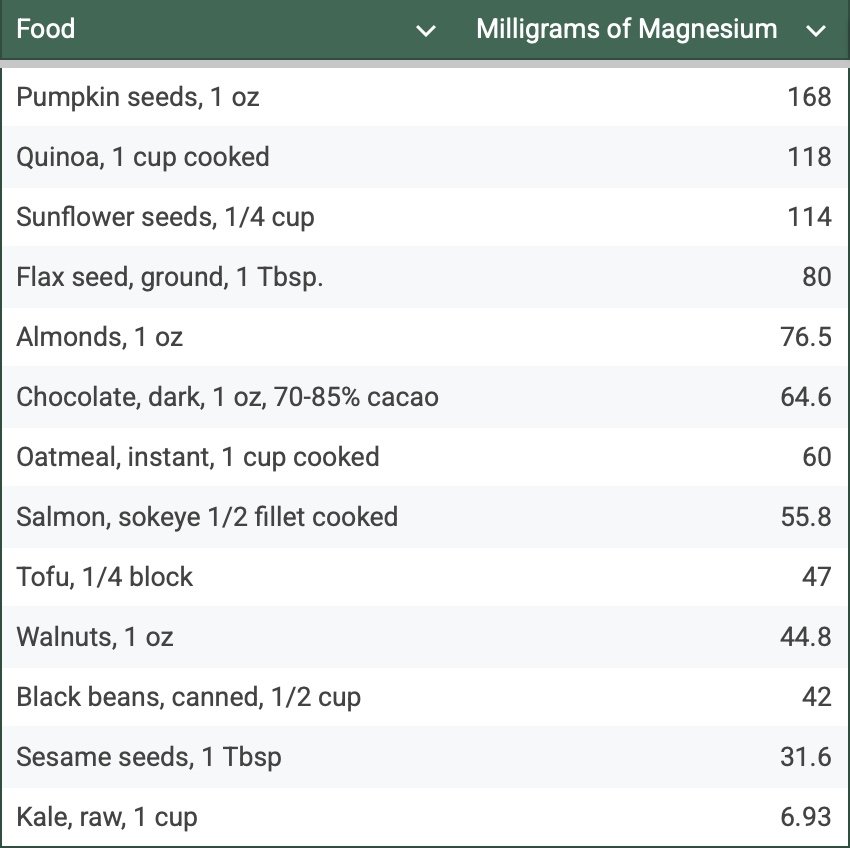Nutrient Spotlight: Foods Rich in Magnesium
Magnesium is an essential mineral found in every organ of the body, playing a crucial role in over 300 biochemical processes. It supports energy production, metabolism, DNA synthesis, and helps produce glutathione, the body’s most powerful antioxidant. Despite its importance, many people do not get enough magnesium, which can contribute to a wide range of health concerns.
Magnesium supplementation can be beneficial for many conditions. Some of the most common issues I see in my practice that improve with adequate magnesium intake include constipation, headaches, chronic stress, skin concerns, osteoporosis, fibromyalgia, menstrual cramps, anxiety, palpitations, sleep disturbances, and muscle aches and pains.
Since magnesium is a natural antispasmodic, it helps relax muscles and relieve tension. Those struggling with restless legs or muscle cramps may be experiencing signs of magnesium deficiency. Individuals with sleep disturbances or muscle-related discomfort often find significant relief by taking magnesium before bedtime.
Magnesium also plays a key role in cardiovascular health. It helps regulate blood pressure, prevents excessive blood clotting, dilates blood vessels, and supports normal nerve conduction in the heart. A severe magnesium deficiency may contribute to high blood pressure, arrhythmias, and coronary artery spasms which can result in chest pain.
One of the primary reasons magnesium intake is often inadequate is the depletion of nutrients in our food. The Standard American Diet, high in refined and ultra-processed foods, lacks the necessary magnesium to support optimal health. Magnesium is most abundant in whole foods such as nuts, seeds, beans, leafy greens, whole grains, and vegetables. However, many people do not consume enough of these nutrient-rich foods.
In addition to poor dietary intake, certain pharmaceutical medications can contribute to magnesium depletion by increasing excretion or requiring higher amounts for metabolism. Medications that commonly cause magnesium deficiency include acid suppressants, blood pressure-lowering drugs, some birth control pills and antibiotics, steroids, and chemotherapeutics. As a naturopathic doctor, I always assess whether a patient’s medications may be contributing to nutrient depletion and recommend dietary adjustments or supplementation to help prevent long-term imbalances.
There are many types of magnesium supplements available, and choosing the right one depends on an individual’s specific health concerns and preferences. Magnesium supplements come in various forms, including capsules, powders, sprays, lotions, and chewable tablets or gummies. For children, I often recommend magnesium lotion or a powdered form that can be mixed into drinks for easier administration. The best magnesium formulation really depends on a patient’s overall health goals, and I work with each individual to determine the most suitable option for them.
As an example, magnesium glycinate is a smaller molecule, making it highly absorbable and less likely to cause diarrhea (a very common side effect of doses higher than 1-2 grams daily). This form is particularly beneficial for individuals dealing with anxiety, headaches, sleep issues, and muscle tension. Magnesium citrate, on the other hand, has a larger molecular structure and serves better as an osmotic laxative, making it more effective for relieving constipation. A naturopathic doctor can help determine the best magnesium supplement for you.
In addition to oral supplementation, magnesium can also be absorbed through the skin. Epsom salt baths are an excellent way to increase magnesium levels while promoting relaxation. Adding two heaping scoops of Epsom salt to a warm bath and soaking for at least twenty minutes can help alleviate muscle tension, headaches, and stress. For many, this simple practice provides a soothing and effective way to support magnesium levels naturally.
The Recommended Daily Allowance (RDA) for magnesium varies by age, gender, and life stage. Remember, The RDA represents the amount of each nutrient needed to meet daily nutrient requirements in healthy individuals. When the body is dealing with added stress or disease, nutrients requirements may be more than the RDA. Here are the RDAs for magnesium across different age groups:
Infants
0-6 months: 30 mg/day
7-12 months: 75 mg/day
Children
1-3 years: 80 mg/day
4-8 years: 130 mg/day
9-13 years: 240 mg/day
14-18 years (girls): 360 mg/day
14-18 years (boys): 410 mg/day
Adults
19-30 years (women): 310 mg/day
19-30 years (men): 400 mg/day
31 and older (women): 320 mg/day
31 and older (men): 420 mg/day
Pregnant and Lactating Women
310-360 mg/day
References:
1. United States Department of Agriculture. FoodData Central. U.S. Department of Agriculture, https://fdc.nal.usda.gov/. Accessed Aug. 2024.
2. Gaby, Alan R. Nutritional Medicine. 3rd ed., Fritz Perlberg Publishing, 2021, pp. 139-145.


